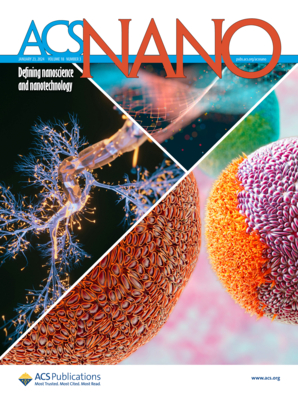中性蒽醌液流电池的双平台单分子氧化还原靶向反应。
IF 16
1区 材料科学
Q1 CHEMISTRY, MULTIDISCIPLINARY
引用次数: 0
摘要
水相有机氧化还原液流电池(aorfb)由于其高丰度、安全性、成本效益和分子设计的灵活性,代表了一种很有前途的大规模储能技术。然而,主动脉主动脉瓣存在能量密度低和稳定性不理想的问题。在这里,我们报告了一个ph中性和高能量密度的基于蒽醌的液流电池利用氧化还原靶向(RT)的概念。有趣的是,在氧化还原介质(RM)蒽醌-2,7-二磺酸二钠盐(2,7- aqds)和固体材料聚(2,5-二羟基-1,4-苯醌-3,6-亚甲基)(PDBM)之间成功设计了具有两个电压平台的单分子氧化还原靶向(SMRT)反应,利用质子耦合电子转移,结合了SMRT和双RM RT系统的优点。本研究的中性RT液流电池表现出令人印象深刻的性能,包括97.1 Ah L-1的高容量(基于阳极液的体积,是空白RFB的14.22倍),99.99%的库仑效率,99.9%的容量保留率,以及92.5%的固体材料利用率。令人鼓舞的是,利用核磁共振和紫外可见光谱对电池循环过程中PDBM和AQDS之间的固液界面进行了动态监测,成功地展示了两种可逆的氧化还原靶向反应过程。本研究开发了一种中性、能量密集的水相有机氧化还原液流电池,广泛阐明了双平台SMRT反应的基本机制,为大规模长时间储能提供了一种有前景的解决方案。本文章由计算机程序翻译,如有差异,请以英文原文为准。
Dual-Platform Single-Molecule Redox-Targeting Reaction in Neutral Anthraquinone Flow Batteries.
Aqueous organic redox flow batteries (AORFBs) represent a promising technology for large-scale energy storage due to their high abundance in nature, safety, cost-effectiveness, and flexibility in molecular design. However, AORFBs suffer from a low energy density and unsatisfactory stability. Herein, we report a pH-neutral and high-energy-density anthraquinone-based flow battery utilizing a redox-targeting (RT) concept. Interestingly, single-molecule redox-targeting (SMRT) reaction with two voltage plateaus is successfully designed between redox mediator (RM) anthraquinone-2,7-disulfonic acid disodium salt (2,7-AQDS) and solid material poly(2,5-dihydroxy-1,4-benzoquinone-3,6-methylene) (PDBM) harnessing proton-coupled electron transfer, combining the advantages of both SMRT and dual-RM RT systems. The neutral RT flow battery in this work exhibits impressive performance with a series of excellent results including a high volumetric capacity of 97.1 Ah L-1 (based on the volume of anolyte, 14.22 times that of blank RFB), a coulombic efficiency of 99.99%, a capacity retention of 99.9% per cycle, and solid material utilization of 92.5%. Inspiringly, operando nuclear magnetic resonance and ultraviolet-visible spectroscopy are employed to dynamically monitor the solid-liquid interface between PDBM and AQDS during battery cycling, successfully demonstrating the two reversible redox-targeting reaction processes. This work develops a neutral, energy-dense aqueous organic redox flow battery, extensively elucidating the fundamental mechanism of the dual-plateau SMRT reaction, presenting a promising solution to large-scale long-duration energy storage.
求助全文
通过发布文献求助,成功后即可免费获取论文全文。
去求助
来源期刊

ACS Nano
工程技术-材料科学:综合
CiteScore
26.00
自引率
4.10%
发文量
1627
审稿时长
1.7 months
期刊介绍:
ACS Nano, published monthly, serves as an international forum for comprehensive articles on nanoscience and nanotechnology research at the intersections of chemistry, biology, materials science, physics, and engineering. The journal fosters communication among scientists in these communities, facilitating collaboration, new research opportunities, and advancements through discoveries. ACS Nano covers synthesis, assembly, characterization, theory, and simulation of nanostructures, nanobiotechnology, nanofabrication, methods and tools for nanoscience and nanotechnology, and self- and directed-assembly. Alongside original research articles, it offers thorough reviews, perspectives on cutting-edge research, and discussions envisioning the future of nanoscience and nanotechnology.
 求助内容:
求助内容: 应助结果提醒方式:
应助结果提醒方式:


